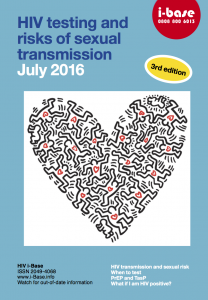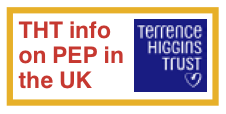PrEP, PEP and PEPSE
1 March 2023. Related: Advocates, HIV positive people, Resources.
This page includes links to information about PrEP, PEP and PEPSE.
PrEP = Pre Exposure Prophylaxis.
 PrEP is the term for using HIV drugs before and after sex.
PrEP is the term for using HIV drugs before and after sex.
If taken as recommended, PrEP is highly effective at preventing HIV infection. It will reduce the chance of getting HIV by at least 99.99%.
PrEP is usually an oral pill, taken daily. Some people (mainly cisgender men) can use event-based or 2:1:1 dosing. This involves only taking PrEP when you are going to have sex. 2:1:1 dosing uses two pills before sex, another after 24 hours and another after 48 hours.
PrEP uses two HIV drugs in one pill before (and after) sex. These are usually generic versions of tenofovir disoproxil (TD) and emtricitabine (FTC). Both these drugs are now off-patent, so PrEP is inexpensive and easily affordable.
See: UK guide to PrEP
In December 2021, a new type if PrEP was approved in Europe and the US. This is a long-acting injection of cabotegravir (CAB-LA). Although it is steadily being approved in other countries too, it is not widely available because of the price.
CAB-LA for PrEP has the brand name Apretude,
PEP = Post Exposure Prophylaxis.
 PEP is the term for using HIV drugs after a high risk exposure to reduce the chance of an infection. I can refer to any type of risk, for example, after a needle stick injury or after sex.
PEP is the term for using HIV drugs after a high risk exposure to reduce the chance of an infection. I can refer to any type of risk, for example, after a needle stick injury or after sex.
PEP involves taking a combination of three HIV drugs every day for one month. After this month you need to wait 4 to 8 weeks before an HIV antibody test will be effective. The time will depend on the type of test you use (see below).
If you test negative after this time, you do not have HIV. You do not need to take further tests.
PEP needs to be taken as soon after sex as possible, ideally within the first few hours. In some countries, PEP is only prescribed within 48 hours of having sex. In a few countries, including the UK, US and South Africa, PrEP can be prescribed up to 72 hours (three days) after.
PEP is unlikely to have any effect if taken more than three days after sex.
PEP is not prescribed in the UK unless there is a significant risk of HIV. For sexual exposure this generally needs to be sex without a condom when HIV status is unknown or if the partner does not have an undetectable viral load on ART.
For more details please see the UK (BHIVA) guidelines on PEP.
www.bhiva.org/PEP-guidelines (website link page)
www.bhiva.org/file/6183b6aa93a4e/PEP-guidelines.pdf (PDF)
Anyone using PEP delays the time until they can take an HIV test. Remember that HIV test only tell you your HIV status 6-8 weeks ago. So to know whether or not PEP worked, you need to wait 6-8 weeks after the last PEP dose.
This is because if the PEP drugs do not stop infection they will work against the new virus.
Testing times
If you are use a 4th generation HIV antigen and antibody test (Ag/Ab), then waiting 6 weeks after your last PEP dose will give you a final answer. If you only wait 4 weeks, then you need to confirm the result with a second test a few months later.
If you are using a 3rd generation HIV antibody only test, you need to wait 8 weeks after your last PEP dose before testing.
PEPSE = PEP after Sexual Exposure
This term is sometimes used in the UK when referring to PEP after sex.
For example if you didn’t use a condom or if the condom broke or came off and your partner is HIV positive and NOT on treatment.
PEPSE is used in the UK to separate this from exposure linked to your job – for example if a health worker has a needle or syringe injury.
Questions to i-Base about PEP and/or PrEP
The i-Base Q&A service has been asked many questions about PEP.
These are links to some of the questions answered online.
- How do I safely use PreP if I buy it online?
- What is PEP? (Post Exposure Prophylaxis)
- I have started PEP and what to know if I will be okay?
- Does PEP have side effects?
- Does PEP extend the window period for testing?
- Other questions and PEP
- Other questions and PrEP
Links to more information and resources
i-Base guide to HIV transmission and testing
Articles from i-Base on reducing HIV transmission
Activists call for urgency of NHS access to PrEP (June 2015)
PrEP reduced HIV risk by at least 86% in PROUD: no transmissions likely from people taking meds. (March 2015)
“On demand” PrEP dosing in IPERGAY: 86% reduced risk of HIV, no transmissions with active drug use. (March 2015)
Other HIV PrEP studies at CROI 2015: implementation of oral PrEP and problems with tenofovir gel. (March 2015)
Q&A on PrEP in the UK and changes to the HIV PROUD study. (October 2014)
UK PROUD study to provide PrEP earlier than expected: planned follow-up in this HIV prevention study to continue for two years. (16 October 2014).
IPERGAY PrEP study shows early efficacy in protecting gay men from HIV: all participants to switch to active drug (October 2014)
US PrEP guidelines: emphasis on broad access may miss optimal use by people at highest risk (May 2014)
The little blue pill that can stop HIV: UK PROUD study (December 2013)
Oral PrEP acceptable to at least 50% of HIV negative gay men – May 2012
CROI 2012: PK modeling of daily TDF/FTC (Truvada) provides close to 100% protection against HIV infection – April 2012
HPA recommends universal HIV testing in the high incidence regions of the UK – December 2011
PrEP study (VOICE) stops use of tenofovir vaginal gel due to lack of efficacy – November 2011
DSMB stops oral tenofovir in VOICE PrEP study: no difference to placebo – September 2011
Treatment is prevention: ARV treatment reduces transmission by at least 96% – August 2011
TDF2 study: Daily oral PrEP reduces heterosexual HIV rates by 63% – August 2011
Tenofovir/FTC vs tenofovir as daily oral PrEP: Partners PrEP study – August 2011
Online presentations on treatment as prevention – August 2011
FEM-PrEP stops daily Truvada: similar infection rates as placebo – April 2011
CROI 2011: ARV prevention: oral PrEP, gels and treatment studies – March 2011
More results from the iPrEx study: daily Truvada protects high risk gay men – March 2011
Topical gels as PEP and PrEP: animal and human studies – March 2011
US CDC issue preliminary guidance for use of PrEP – February 2001
PrEP reduces transmission in gay men at high risk: iPrEx study – December 2010
Links to other websites
UK (BHIVA/BASHH) guidelines on PEP (2021).
www.bhiva.org/PEP-guidelines (website link page)
www.bhiva.org/file/6183b6aa93a4e/PEP-guidelines.pdf (PDF)
Information on THT website about PEP in the UK
Letter from Chief Medical Officer to ensure PEP is available in all UK hospitals
This important edition of Research Initiative, Treatment Action (RITA!) interviews key researchers and features two comprehensive reviews of preexposure prophylaxis (PrEP).
